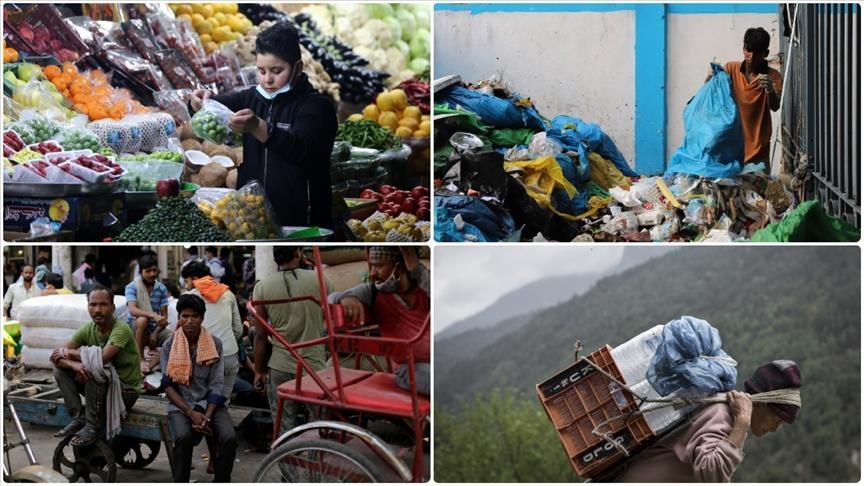

By Anadolu Agency
BRUSSELS
The biggest crisis in the world economy in almost a century was caused by the coronavirus pandemic, the effects of which are being recovered from only after four years.
After the first COVID-19 case was detected in the Chinese city of Wuhan at the end of 2019, the virus spread rapidly around the world, resulting in countries closing their borders and implementing restrictive measures to protect citizens.
While the world economy came to a standstill due to the various measures against the pandemic during the first months of 2020, economic activity was largely suspended, except for critical sectors in the fight against the crisis, such as health care, food and beverage, agriculture and transportation.
The serious halt in production and life disrupted the global economy and trade, and countries focused on public health-oriented policies, locking citizens in their homes for their safety.
In light of the developments, the financing of the policies implemented to address wage problems and the loss of production and employment also reached serious levels.
Countries with stronger public finances and economic means were able to protect their citizens from the crisis to some extent through supportive policies, while weaker ones felt it deeply.
National interests put global approaches in shade
Many countries that normally act in concert turned to national interests and displayed selfishness and trade protectionism gained ground.
The failure to identify a common worldwide position on how to emerge from the economic recession and widespread suspension of economic activity further weakened countries, especially those with more vulnerable economies.
Strict lockdown and quarantine measures led to fewer cases and deaths but as countries tried to return to normalcy to overcome the effects of the economic crisis, they were repeatedly disrupted by the emergence of new waves and variants of the virus.
Although there have been previous periods of slowdowns in the world economy, a complete standstill of the COVID-19 caliber had never before been seen.
World economy sees severe reduction during pandemic
Although the world economy grew 2.6% in pre-pandemic 2019, it shrank 3.1% in 2020, according to the World Bank, a decline unprecedented since the Great Depression in 1929.
A growth rate of 6% was realized worldwide in 2021 due to the easing of the pandemic’s effect and the low base effect, while the rate eased to 3.1% in 2022.
As for 2023, the growth forecast is 2.7%.
The unemployment rate worldwide spiked 1.36% in 2020 year-on-year due to the pandemic, reaching 6.9%, while the jobless rate for young people and women soared.
The number of unemployed worldwide went up by 33 million to 220 million in 2020 alone, in the first period of the pandemic.
Global unemployment fell to 6.2% in 2021 and 5.77% in 2022, while in 2023, it remained above 2019’s pre-pandemic level.
Global trade on decline
Global trade in goods and products fell 9% in 2020, a decline that had never been predicted, according to the World Trade Organization (WTO).
Global goods exports decreased from $19 trillion to $17.6 trillion in 2019, while exports of goods and products rose to $22.3 trillion in 2021, and to $24.9 trillion in 2022, according to data compiled by Anadolu.
Pandemic-induced supply chain problems pushed up consumer prices and rendered products harder to find, leading to an increase in inflation.
The pandemic caused delays in production and problems in sea transports, especially in Asian countries, as freight prices peaked, resulting in transportation costs especially for long distances, hiking rapidly, introducing significant supply delays.
New issues emerged as the pandemic eased and the world went into economic recovery.
The surge in transportation costs for long distances prompted foreign international companies to find appeal in Türkiye for its proximity, stability, and strategic advantages for investment.
Aviation, tourism suffer especially
Restrictive measures to combat the pandemic, such as the closure of borders and travel bans, plunged the service sector, especially transportation and tourist accommodation, into an otherwise unheard-of crisis.
The ban on non-essential travel significantly reduced demand for air travel, bringing air traffic to a halt in what severely jeopardized aviation, an extremely capital-intensive sector, in which continuous cash flow is crucial. In some areas, flights were down by almost 90% compared to pre-pandemic levels.
Many countries made efforts to pull airlines out of the crisis.
It was only in 2023 that the aviation sector was able to recapture pre-pandemic levels for flights and passengers.
Tourism took four years to overcome the crisis and recover, as accommodation and touristic businesses were brought to the point of closure by pandemic restrictions.
The sector only gradually regained pre-pandemic customer numbers in 2023.
Strategic importance of food, agriculture revealed by panic buying
The pandemic also had notable ramifications on the global agriculture sector, once again demonstrating how critical agriculture and animal husbandry are to economies.
As people flocked to stores due to the restrictions that came into force, people flocked to buy pasta, rice, flour, legumes and canned goods.
Agricultural and food production had been listed as critical sectors since the beginning of the pandemic, allowing them to continue activities with minimal disruption.
Numerous measures and permits were put in place to ensure food shipments would continue without disruption.
Some countries imposed restrictions on the export of agricultural goods and food to protect themselves from famine, which revealed the need to identify new strategies against restrictions on food and agriculture in global trade.
We use cookies on our website to give you a better experience, improve performance, and for analytics. For more information, please see our Cookie Policy By clicking “Accept” you agree to our use of cookies.
Read More